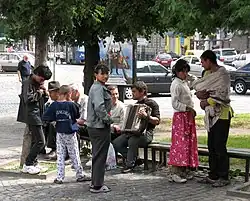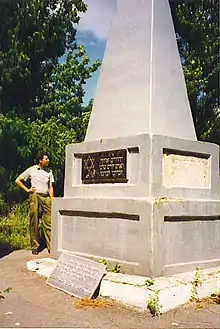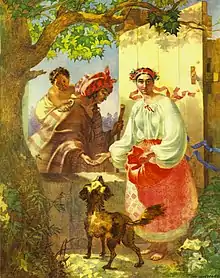Romani people in Ukraine
The presence of a Romani minority in Ukraine was first documented in the early 15th century.[3] The Romani maintained their social organizations and folkways, shunning non-Romani contacts, education and values, often as a reaction to anti-Romani attitudes and persecution. They adopted the language and faith of the dominant society, being Orthodox in most of Ukraine, Catholic in Western Ukraine and Zakarpattia Oblast, and Muslim in Crimea.
| Total population | |
|---|---|
| 47,587 (2001 census),[1] est. 400,000[2] | |
| Regions with significant populations | |
| Zakarpattia region and Odesa region | |
| Languages | |
| Ukrainian, Para-Romani | |
| Religion | |
| Eastern Orthodoxy, Islam |
| Part of a series on |
| Romani people |
|---|
|
Romani diaspora by country
|
|
History
Origin
The Romani people originate from Northern India,[4][5][6][7][8][9] presumably from the northwestern Indian states Rajasthan[8][9] and Punjab.[8]
The linguistic evidence has indisputably shown that roots of Romani language lie in India: the language has grammatical characteristics of Indian languages and shares with them a parts of the basic lexicon, for example, body parts or daily routines.[10]
More exactly, Romani shares the basic lexicon with Hindi and Punjabi. It shares many phonetic features with Marwari, while its grammar is closest to Bengali.[11]
Genetic findings in 2012 suggest the Romani originated in northwestern India and migrated as a group.[5][6][12] According to a genetic study in 2012, the ancestors of present scheduled tribes and scheduled caste populations of northern India, traditionally referred to collectively as the Ḍoma, are the likely ancestral populations of modern European Roma.[13]
In February 2016, during the International Roma Conference, the Indian Minister of External Affairs stated that the people of the Roma community were children of India. The conference ended with a recommendation to the Government of India to recognize the Roma community spread across 30 countries as a part of the Indian diaspora.[14]
2022 Russian Invasion of Ukraine
During the 2022 invasion of Ukraine, Roma people suffered since the often lack of civil status documentation held off their access to humanitarian assistance. Several sources report denying refugees access to European countries.[15] EU Agency for Fundamental Rights (FRA) called for special attention to Roma seeking sanctuary.[16]
The previous discouragement of the education of Roma girls hit them harder after the war disturbance in the education system.[17] Romani Ukrainians are also fighting Russian soldiers in Liubymivka.[18] Despite being part of a marginalized minority, hundreds of Roma volunteered to fight for the Ukrainian army and were awarded.[19][20]
Demographics
- Census 1897: 12,000 Romani in Ukraine (without Galicia and Transcarpathia who comprise the highest Ukrainian Romani population)
- Census 1920: 60,000 Romani in Ukrainian SSR (without Galicia and Transcarpathia)
- Census 1959: 28,000 Romani in Ukrainian SSR
- Census 1970: 30,100 Romani in Ukrainian SSR.
- Census 1979: 34,500 Romani in Ukrainian SSR
- Census 2001: 47,587 Romani in Ukraine.[1] The estimate of the World Romani Union and the Council of Europe is considerably higher. In 2006 the Romani organizations estimated the number at over 400,000 persons.[2]
Romani are scattered throughout Ukraine, but their largest concentration is in Zakarpattia Oblast. Half live in cities. 35% consider Romani their mother tongue. Material culture has not differed from the dominant society except in dress. They have a rich folk tradition. Romani themes can be found in Ukrainian literature.
Sub-groups
The Muslim Roma migrated from Central Asia in the 17th and 18th century to Crimea peninsula.[21]
- Krimi (Крими), intermingled with Crimean Tatars. Further sub-groups include Audzhi (аюджі), Gurbety (гурбети), Mukani and others. During World War II Nazis killed 800 Krimi Roma in Simferopol. After the Nazi occupation, Stalin ordered all Crimean Tatars and Crimean Romani to be deported to Central Asia as "special settlers" in 1944, further devastating their community.
- Gurbeti: The gypsy communities in Crimea in the 19th century were divided by "Yerli" (Yerli) and "Chingene" (Nomad).[22] The Gurbeti (sometimes called Turkmen), lived mainly in the towns and steppe regions.[22] They traded horses and products made out of horse meat (such as the popular chir-chir-byurek).[22] The Krimurja in Crimea incorporated small numbers of Gurbeti through marriage, although in the 19th century they are listed as a separate group of "locals".[23] Their small number likely prevented them from an own community.[23] Their Romani language and nomadic lifestyle determined their separation to the Daifa, and their joining to the Krimurja.[23] In spite of intermarriage between the Gurbeti and Krimurja, a distinct origin is remembered, and an internal separation to some extent has been preserved.[23] Some in Crimea suggest that the "chingene" deny their gypsy origin and declare as Crimean Tatars.[24]
- Carpathian Romani The largest number of Roma is in the city of Mukachevo (1.4%), in Vynohradiv (0.8%), Berehove (4.1%) and Uzhgorod (4.1%) districts of the Transcarpathian region.[25][26]
- Kalderash (Hungarian name for Kotlyary; Zakarpattia),
- Servica Roma (in Zakarpattia from Slovakia),
- Ungriko Roma (in Zakarpattia from Hungary)
- Chaladitka Roma (descended from Polish Roma)
- Ruska Roma (northern Ukraine),
- Servitka Roma (Serby, southern and central Ukraine, from Serbia), Servitka live scattered in small groups among representatives of other ethnic groups. They are characterized by living in large cities of Zhytomyr and Chernihiv regions (cities of Chernihiv, Zhytomyr, Korosten, and Malyn).
- Lovari (central Ukraine), most representatives of the Lovari group have their compact settlements in Zhytomyr (Bohunia district), Teterivka village of Zhytomyr district and in the city of Malyn.
- Kelmysh, In the city of Bila Tserkva lives a group of gypsies-kelmish. In the Cherkasy region, kelmish live not in cities, but in gypsy villages that emerged in the 60s of the XX century. The main region of settlement is the town of Smila and its surroundings.
Gallery
 The Romani minority in Zakarpattia Oblast (census 2001)
The Romani minority in Zakarpattia Oblast (census 2001) Romani children in Dubove, Zakarpattia Oblast
Romani children in Dubove, Zakarpattia Oblast Romani people in Lviv
Romani people in Lviv.jpg.webp) Romani people in Galicia in 1895
Romani people in Galicia in 1895 Monument at the Nazi mass killing site in Derazhnia. Approximately 4,000 Jews and Romani were shot here on 20 September 1942
Monument at the Nazi mass killing site in Derazhnia. Approximately 4,000 Jews and Romani were shot here on 20 September 1942 "Gypsy Fortune-Teller" 1841 watercolor composition by Taras Shevchenko
"Gypsy Fortune-Teller" 1841 watercolor composition by Taras Shevchenko
Notable people
See also
References
- "The distribution of the population by nationality and mother tongue UKRAINE". Archived from the original on 14 September 2007. Retrieved 19 May 2007.
- : In reality, by the preliminary estimates of communication within our nation, only the East of Ukraine has approximately 150 thousand Romani nationals, and we are sure that the Romani population on the territory of Ukraine reaches more than 400 thousand people.
- Volodymyr Kubijovyc (1988). Encyclopedia of Ukraine: Volume II: G-K.
- Hancock, Ian F. (2005) [2002]. We are the Romani People. Univ of Hertfordshire Press. p. 70. ISBN 978-1-902806-19-8: ‘While a nine century removal from India has diluted Indian biological connection to the extent that for some Romani groups, it may be hardly representative today, Sarren (1976:72) concluded that we still remain together, genetically, Asian rather than European’
{{cite book}}: CS1 maint: postscript (link) - Mendizabal, Isabel (6 December 2012). "Reconstructing the Population History of European Romani from Genome-wide Data". Current Biology. 22 (24): 2342–2349. doi:10.1016/j.cub.2012.10.039. PMID 23219723.
- Sindya N. Bhanoo (11 December 2012). "Genomic Study Traces Roma to Northern India". New York Times.
- Current Biology.
- Meira Goldberg, K.; Bennahum, Ninotchka Devorah; Hayes, Michelle Heffner (2015-09-28). Flamenco on the Global Stage: Historical, Critical and Theoretical Perspectives - K. Meira Goldberg, Ninotchka Devorah Bennahum, Michelle Heffner Hayes - Google Books. ISBN 9780786494705.
- Simon Broughton; Mark Ellingham; Richard Trillo (1999). World Music: Africa, Europe and the Middle East. Rough Guides. p. 147. ISBN 9781858286358.
Roma Rajastan Penjab.
- Šebková, Hana; Žlnayová, Edita (1998), Nástin mluvnice slovenské romštiny (pro pedagogické účely) (PDF), Ústí nad Labem: Pedagogická fakulta Univerzity J. E. Purkyně v Ústí nad Labem, p. 4, ISBN 80-7044-205-0, archived from the original (PDF) on 2016-03-04
- Hübschmannová, Milena (1995). "Romaňi čhib – romština: Několik základních informací o romském jazyku". Bulletin Muzea Romské Kultury. Brno: Muzeum romské kultury (4/1995).
Zatímco romská lexika je bližší hindštině, marvárštině, pandžábštině atd., v gramatické sféře nacházíme mnoho shod s východoindickým jazykem, s bengálštinou.
- "5 Intriguing Facts About the Roma". Live Science. 23 October 2013.
- Rai, N; Chaubey, G; Tamang, R; Pathak, AK; Singh, VK (2012), "The Phylogeography of Y-Chromosome Haplogroup H1a1a-M82 Reveals the Likely Indian Origin of the European Romani Populations", PLOS ONE, 7 (11): e48477, Bibcode:2012PLoSO...748477R, doi:10.1371/journal.pone.0048477, PMC 3509117, PMID 23209554
- "Can Romas be part of Indian diaspora?". khaleejtimes.com. 29 February 2016.
- "Romani family denied exit from Ukraine: border guards accuse Roma of "wrongdoings" in Hungary". European Roma Rights Centre (in Hungarian). Retrieved 2022-04-18.
- "Ensure equal treatment for Roma fleeing Ukraine". European Union Agency for Fundamental Rights (in Dutch). 2022-04-01. Retrieved 2022-04-18.
- "Rapid gender analysis in Ukraine reveals different impacts and needs of women and men". UN Women – Headquarters. 2022-04-05. Retrieved 7 April 2022.
- "Roma from Kherson oblast in Ukraine capture tank from Russian occupiers".
- "Almost 200 pro-Roma and Romani organizations worldwide condemn Russia's war on Ukraine, call for it to end and for the human rights of all refugees to be upheld". romea.cz. Retrieved 2022-04-18.
- "Braća po oružju: Zbog pomoći protiv ruske agresije mijenja se stav Ukrajinaca prema Romima". www.klix.ba (in Bosnian). Retrieved 2023-04-10.
- Gypsies in Central Asia and the Caucasus. 2016. ISBN 9783319410562.
- Geisenhaner-Lange, p. 427
- Geisenhaner-Lange,p. 437
- Geisenhaner-Lange, p. 432
- Січ, Нова. "Нова Січ – Новини – Історія українських циган". Novasich.org.ua. Retrieved 30 August 2017.
- Helbing Adriana, Ukraine: Performing Politics, 28 February 2006
Sources
- Encyclopedia of Ukraine Vol. 2 (G-K) Toronto, 1988
- УКРАЇНСЬКІ ЦИГАНИ